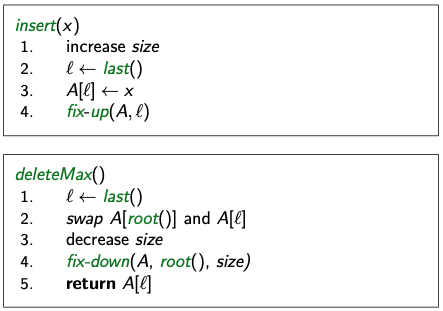Binary Heap
A binary heap is a certain type of Binary Tree. Less strict than a binary tree, each node’s children needs to be smaller or bigger than the parent node. A Binary Heap is another way of implementing a Priority Queue.
A heap is a binary tree with the following two properties:
- Structural Property: all levels of a heap are completely filled, except (possible) for the last level.
- Heap-order Property: For any node , the key of the parent is larger than or equal to key of . max-heap Lemma: The height of a heap with nodes is
Run-time for creating binary heap:
- using Heapify (bottom-up approach)
- using insertion? (top bottom approach)
Storing Heaps in Array
Let be a heap of items and let be an array of size . We store the root in and continue with elements from top to bottom, in each level left-to-right.

- root node at index
- last node
- left child node
- right child node
- parent node
Functions:
- root()
- last()
- parent(i)
Operations in Binary Heaps
Insert
- Place new key at the first free leaf
- Perform fix-up since heap-order might be violated.
Time complexity of insert: (height of heap)
fix-up
Pseudocode:

deleteMax
- The maximum item of a heap is at the root node
- Replace the root by the last leaf (last leaf is taken out)
- The heap-order property might be violated fix-down
Time complexity of deleteMax: (height of heap)
fix-down
Pseudocode:

- small node from the top, swap with bigger node
Priority Queue Realization Using Heaps
- Store items in array and globally keep track of size

- insert and deleteMax time
Sorting using heaps
Remember from Priority Queue sorting have time:
Using binary-heap to implement PQs we have:

- since both insert and deleteMax run in time for heaps
- PQ-Sort using heaps takes time.
Questions
- Given an array of elements, what are the possible runtimes for creating a binary heap from all the elements of using the algorithms discussed in lecture?
- Insertion (top-bottom)
- Heapify
- In a max-heap implemented as an array, an item with the smallest key must be the last valid item in the array.
- False
- In a max-heap implemented as an array, at least one of the leafs must be an item with the smallest key.
- True
- Given a max-heap of items (implemented as described in class) and a key value , the problem of searching for in can be solved in time.
- False, it is using PQ-sort.
- In a max-heap implemented as an array, an item with the smallest key may be the strict ancestor of some leaf node (i.e. not the leaf node itself).
- True, but why?
- In a max-heap implemented as an array, an item with the largest key cannot be a leaf node.
- False, what if it’s only a root, it is also a leaf?